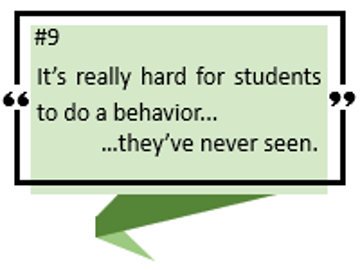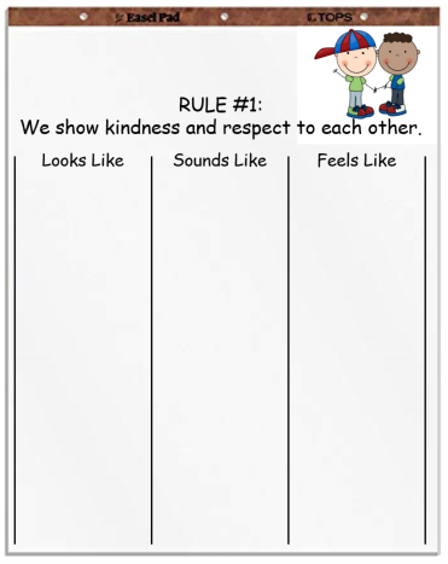30 Mar Word of Wisdom #9: Showing and Teaching Desired Classroom Behaviors
The most difficult behavior for a student to do is the one he or she has never seen.

WHOSE JOB
We expect our students to follow classroom rules and procedures. Yet how often do we check to see if students have a clear understanding of what a specific classroom rule really means? Do students know what they are to do, and how and when they are to do it? Do the words of a written classroom rule create the same images in the students’ minds as in the teachers? (Note: Some secondary teachers find that the term “class policy” instead of “class rule” is more accepted by students.)
THE DIFFERENCES IN TELL – SHOW – DO
Tell, show, do, apply – four steps that are the anatomy of good instruction (see https://elearningindustry.com/tell-show-do-apply-the-anatomy-of-good-instruction).
Take a trip down memory lane with me – back to that most awkward time of life called emerging adolescence and those most painful years known as “middle school.” Now enter that one class that awkward and un-athletic students like me feared: PE. You’ve changed into gym clothes, lined up on the bleachers as instructed, and come to attention as the PE instructor blows her whistle. In her hand she holds a tennis racket, and with enthusiasm she loudly announces, “Today, class, you will play tennis.” Now engage your imagination with me in the next three scenarios:
SCENARIO 1: You’ve heard the word tennis before, and you think it has something to do with hitting a ball over a net. But you’ve never seen it played – much less tried it yourself. Now, in front of your classmates, you are expected to do it. How do you feel? (Is your stomach churning? Does your head hurt? Do you need to be excused to see the nurse?) What are your chances for success?
SCENARIO 2: Your brother plays tennis. While you’ve never played yourself, you have often watched him play on the courts at a nearby park. Now how do you feel? (More confident than in the first scenario?) What are your chances for success?
Scenario 3: Your brother plays tennis. Last weekend he took you to the local park tennis courts with him. He taught you how to serve the ball, and the two of you lightly lobbed it back and forth over the net a few times. Now how do you feel? (Rarin’ to go?) What are your chances for success?


Seeing something done correctly makes a difference; practicing it correctly makes an even bigger one.
“BETTER COOL THAN A FOOL”
Ever been in a situation where you were not quite sure what to do – or how to act – and there were others around you? Maybe it was your first time at a school dance or at a formal dinner. How did you cope? Humor? Withdrawal? Cautious copying of others’ behavior?
Some students, when faced with a situation in which they feel that are about to look inadequate in front of their peers, cope by “acting up” in the hopes of “getting sent out.” It’s a coping mechanism to avoid embarrassment. And it is definitively a way to gain peer recognition. Students – especially adolescents – would much rather be thought cool than a fool by fellow students.
So how can a teacher avoid placing students in this kind of situation? Remember WOW #5: Make visible your invisible expectations?
True Story – Meet Korak
A middle school teacher friend of mine, Linda Bain, created a proactive, nonthreatening way to deal with potential student embarrassment from a lack of knowledge. At the beginning of the year, in the front corner of the classroom, she placed an empty student desk. When students asked, “Who’s desk is that?”, her response was “Korak’s desk.” And to the question of “Who’s Korak?”she explained that Korak is a Martian who has come to Earth to learn to communicate with Earthlings. As a class, was their job to help Korak learn in ways and language he understands. This little fellow then served to clarify rules and procedures and academic content throughout the year. For example, when going over class rules and procedures, class members would take turns “showing Korak how it’s done.” Students bought in to this little fellow – and he even showed up in the school yearbook as a member of the class.

Korak even showed up in the school yearbook as a member of the class.
THE LOOK-SOUND-FEEL APPROACH
I borrow from another teacher friend, this time in an elementary school, who uses a chart to teach second graders classroom rules. Her students come from a variety of cultural backgrounds, and what is considered respectful behavior in one home may not be acceptable in another.
My teacher friend says it is her responsibility to teach students what “respect” will look, sound, and feel like in their classroom. She invests time at the beginning of the year helping students list examples in the columns of a Look-Sound-Feel chart.
She begins by providing scenarios for the students, and then invites them to add some of their own. For example, If someone at your table needs a pencil, what would kindness and respect look like, sound like, and feel like? Giving students the opportunity to discuss alternative ways of responding to situations before those situations occur results in more classroom-appropriate behavior.

A look-sound-feel chart is a useful tool in teaching specific behaviors that follow class rules.
In the three tennis scenarios above, Scenario 3 with its opportunity to practice a bit beforehand is definitely the preferred. No coach would describe a game plan to players and then say, “See you at the game.” No. Practice is needed. And critiquing of the practice to approach perfection. Contrary to the old saying, practice alone does not make perfection. Practice plus coaching plus feedback plus time leads to mastery. But there has to be PRACTICE through role play before you can do any coaching and provide formative feedback. Consider the possible practice scenarios for a rule dealing with respect for others:
- Two people go to the door and demonstrate what respect looks and sounds like when both want to get through the door at the same time.
- Three people and come up and demonstrate what respect looks and sounds like when one is talking with the teacher and each of the other two want to be next.
- Four people go just outside the door and demonstrate what respect looks and sounds like when one accidently drops books and blocks the doorway.
- The class demonstrates what respect looks and sounds like when a student gives an incorrect response.
- Two people come up front and demonstrate what respect looks like and sounds like when one accidentally bumps into the other.
Suggestion: When having students role play these scenarios, begin with students who you believe know how to do the scenario correctly. Then allow others who have seen the correct behavior – but perhaps never done it themselves – demonstrate it themselves.
The Responsive Classroom offers some excellent elementary classroom examples of role play at https://www.responsiveclassroom.org/bringing-classroom-rules-to-life/. And it is not that much of a stretch to think how similar practice could be done at middle and high school levels.
Consider what classroom rules you have that might benefit from a bit of situational practice through role play.
CAUTION: A ROLE PLAY NO-NO
Sometimes students ask (make that beg) to role play the non-example. NO WAY! Chances are they have already seen – and/or done – the non-example that you do NOT want played out in your classroom. Students who role play the non-example can tend to get a bit rambunctious.
If any role playing is to be done of a non-example, it should be done by you as the teacher. Indeed, when the teacher “misbehaves,” it makes the misbehavior look even more ridiculous and out of place. And it keeps you as the teacher in control of the classroom.
Now I’ve given this bit of advice and warning in every workshop that touched on teaching class rules. And teachers who have ignored the warning and given in to students’ pleading have come back to tell me that the warning was accurate – and they will never make that mistake again.
Until next week – may you experience success in all your academic endeavors!
Alene


